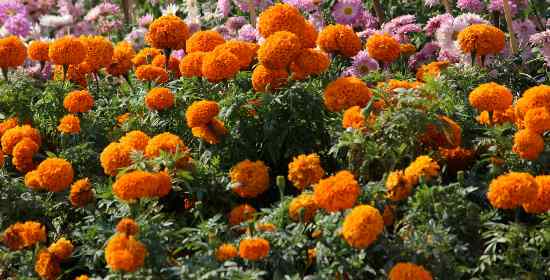We use affiliate links to run our site. When you buy through links on our site, we may earn an affiliate commission, without any added cost to you. Learn more
Marigolds are very easy to grow, making them a favorite for new gardeners. But that doesn’t mean they don’t require a little extra attention when it comes to watering.
Watering is an essential part of growing marigolds. Without it, your plants will suffer from stress and may even die.
There are many factors that contribute to watering marigolds – the size of the pot, sun exposure, soil type, and temperature are just some of them. Learn the best times to water marigolds, plus some other tips, here.
But before we get into all that, let’s take a look at why we should be watering our marigolds in the first place.
The Importance Of Watering Correctly:
Water is essential for life and plants are no different. Plants absorb water through their roots and send it up through the stem and to the leaves so that they can photosynthesize and produce food for themselves.
To grow properly, plants need a lot of water. Without enough water, plants will suffer from dehydration which is fatal in most cases.
When it comes time to water your marigolds, it’s important not to over-water them or under-water them.
If you have too much water on them, the leaves will become limp and droop over time. This can result in stunted growth and even death of the plant if conditions aren’t corrected quickly enough.
On the other hand, if you don’t have enough water on your marigolds, then they won’t grow properly either. The leaves will start dying off and fall off before you know it!
When To Water Marigolds
Marigolds are drought-tolerant plants and can survive with little water if necessary. However, it’s much better if you give them regular watering intervals instead of letting the soil dry out completely between waterings.
Use deep and slow watering around the plants once a week. If the plant is getting rainwater regularly then you don’t need to water them anymore.
This way, the roots can develop properly and become stronger over time without being damaged by too much sun or heat exposure during dry periods in between waterings. They can survive for weeks without water so it’s important not to overdo it!
However, if there has been a dry spell or if your plants have been in the ground for longer than usual – or if you live somewhere with a lot of dust in the air – then they may need more water than usual.
Do Marigolds Prefer Moist or Dry Soil?
Initially, marigolds prefer moist soil conditions because it makes the roots grow larger and stronger over time. once they get established you can limit watering.
How To Water Marigolds:
In-ground – In an area where the marigold seeds have been planted in the ground, you will want to make sure that the soil is moistened thoroughly before watering again. Simply pouring water around the base of each plant should do the trick!
One of the best things you can do to water your marigold plants is to install a drip irrigation system that will reduce the effort considerably.
In pots – If your marigolds are growing in pots or containers, then you should pour water directly into the container until there is a good amount of excess moisture at the bottom. You should then allow this excess moisture to drain out before adding any more.
Never water your marigold plants over the top. This way water will get trapped inside the flowers and leaves resulting in molds and fungal growth.
Read this guide on how to water your plants properly.
Factors that can affect your watering schedule:
There are numerous factors to consider when determining how often to water your marigold plant. Factors like weather, sunlight, the season of the year, and spacing all play a role.
Weather:
Weather can play a critical role in how often or how much you would water the plant. So, if you have heavy rainfall, you might not need to water them at all.
Don’t water if rain is expected within 24 hours. Marigolds prefer moist but not overly wet soil conditions, so watering after rain can cause root rot or fungus problems if the soil is left too damp for too long after watering.
If you live in an area with high humidity, it’s best not to water at all during rainy spells as this can encourage fungal growth on plant surfaces that could cause leaf spotting or powdery mildew.
Sunlight exposure:
Marigolds are known as sun plants, meaning they prefer full sun to partial shade. The more sunlight they receive, the better they will grow.
Interestingly, this will also impact how much and how often you should water the plant.
If they are growing in full sun you need to water more frequently, whereas if your marigolds are in partial shade you can reduce the watering frequency.
Keeping the marigold plant well watered in these seasons ensures that they’ll be able to produce healthy new shoots of fresh marigolds in the future.
Seasonality:
The seasons also affect how often you should water your marigolds because each season has different weather conditions that affect how much moisture is needed for the plant.
Spacing:
When we discussed marigold planting we put some importance on the spacing. Depending on how much space there is between two marigold plants the amount and frequency of watering will also change.
Plants that are planted close together will compete for the same water, and as a result, you’ll have to water them more compared to the loosely planted marigolds.
Signs Of Underwatering:
If your marigold shows signs of under-watering such as wilting, yellow leaves, or brown spots on leaves then this means that they are not getting enough water.
You should increase the frequency of watering until they start showing signs of normal growth again like strong stems, fresh green leaves, and buds forming at the base of each stem.
Signs of Overwatering:
If your marigolds are getting too much water, you will start seeing signs of overwatering very quickly.
The leaves will droop down towards the ground and will also turn yellow at the base because they have been weakened by too much water.
You will also find mushy stems and leaves especially at the base of the plant.
But most importantly if you overwater your marigold plants the roots will start to rot, and eventually, the plant will die.
Watering New Plants:
Watering new plants is important to establish a good root system. Water the soil until it is moist at least an inch deep. Do not let your marigold plant sit in water.
Watering Established Plants:
Established marigolds do not need to be watered as frequently as new marigolds and can go for several days without water before wilting.
If you are growing marigolds in containers or raised beds, make sure to check the soil about once a week for dryness and water them as needed.
When to water marigold planted in containers:
For marigolds grown in containers watering frequency will be different. As the plants are restricted to the soil inside the container only, their moisture resource is also very limited.
So, rather than waiting a week to water, keep an eye on the soil. Water when the top two inches have dried out completely.
How much water your marigold needs depends on the size of its container and how warm it is outside. If your marigold is in a large pot or it is outside, you may need to water it every day during the hot summer months.
Tips for watering your marigold plant
- If you are growing marigolds in containers make sure your pot has adequate draining. Make sure the drainage hole is not blocked and the type of soil mix you are using does have proper drainage.
- Wilting leaves doesn’t always means the plant lacks water, it can also due to overwatering. So before deciding on watering your plant again make sure you check the soil properly.
- Never apply fertilizer to the dry roots. It can make your plant vulnerable to chemical burns. Always water your plants well the day before you fertilize. even if you use a water-soluble fertilizer.
conclusion
I hope this post was helpful to you.
Watering is an essential part of growing any plant. It can affect growth, color, and health, so it’s important to keep your plants hydrated at all times.
In fact, if you want them to thrive and grow quickly then you need to ensure they have enough water in their system at all times.
You can read more posts related to growing marigolds here.
If you like the information, share it with others, and Don’t Forget to PIN IT.

Amazon and the Amazon logo are trademarks of Amazon.com, Inc, or its affiliates.

Hi there! My name is Prasenjit and I’m an avid gardener and someone who has grown a passion for growing plants. From my hands-on experience, I have learned what works and what doesn’t. Here I share everything I have learned.
